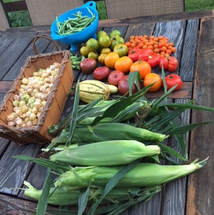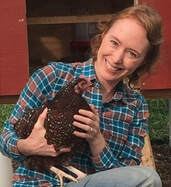 Just one of this week's harvests...
Just one of this week's harvests... I always forget how productive certain crops (i.e. tomatoes) can be until another summer rolls around and they are rotting in piles on the counter, as well as under the plants in the garden. I thought I had sufficiently scaled down my tomato planting this year, but apparently not quite far enough!
Anyway, we canned our first batch of tomatoes this weekend, and froze some as well - along with a number of other food preservation tasks.
Below is a quick list of what I was up to this weekend in the homestead kitchen - along with some pictures of the bounty, and a quick run-down of our tomato canning process...
 Ready for canning!
Ready for canning! This week's canning efforts involved mostly Novas, but I did include a few of an odd unknown variety my mom gave us some seeds for (which I accidentally planted, mistaking them for Cherokee Purple!). I don't care for the small, red, striped tomatoes at all (they tend to be mushy and not very flavorful), but I discovered that they cook down into a wonderfully thick sauce, so I figured they would be a good addition to the jars.
Our canning process goes as such:
1.) Heat our giant canning kettle to a boil with jars for sterilizing (it fits 7 quart-sized jars, or about 9-10 pints).
2.) Heat a large saucepan about half-full of water - to boiling for skinning the tomatoes.
3.) Meanwhile, wash our largest stainless steel bowl full of tomatoes.
4.) Remove scalded jars to a mat to cool and turn down the kettle while my husband starts coring tomatoes and removing any bad spots he finds, filling another bowl with the prepped tomatoes.
5.) I take his prepared tomatoes (about 5-6 at a time, as they are fairly small), and drop them into the saucepan of boiling water for approximately 1 minute, then remove them with a slotted spoon into a bowl of cold water (I don't use ice - it's more time consuming and also unnecessary - they peel perfectly fine in cool tap water.)
6.) Slip off the skins (which go in the compost strainer), and fill another bowl with the peeled tomatoes.
7.) Once I have a backlog of tomatoes which haven't been peeled yet, my husband takes the peeled ones and starts dicing them coarsely - into quarters or large chunks. These go in a large pot which goes on the stove on medium-low heat to start cooking.
8.) We continue this process until our pot is about 2/3 full of simmering chopped and peeled tomatoes. (This fills about 7 quarts.)
9.) Turn up the heat on the canning kettle and clean up the kitchen a bit and prep the jars for filling while the tomatoes cook a little longer. Quart jars each get 1/2 tsp salt and 2 TB lemon juice (I use the bottled stuff from the store).
10.) Remove tomatoes from the heat and add a small saucepan filled with water from the canning kettle, into which go the lids for the jars for sterilizing.
11.) While these boil, fill the jars with the hot tomatoes. (A canning kit is essential for all of this, by the way, and not very expensive. Mine includes a plastic canning funnel, a magnetic lid lifter, and a jar lifter.)
12.) Wipe the mouths of the jars carefully with a hot, wet paper towel to make sure there is no tomato residue that might prevent a good seal.

14.) Using the jar lifter, carefully place each jar into the canner. The tops of the jars should just be covered with water.
15.) Bring the water to a boil, then set a timer for 45 minutes (30 minutes for pints). Make sure the water stays at a low boil the whole time. Boiling too hard may cause a loss of sauce from the jars into the canning water - a mistake I have made more than once!
16.) Once the time is up, remove jars from the canner and set on a mat to cool. After 24 hours, check to make sure the lids are all depressed and sealed, remove rings and clean jar necks with a wet towel to remove any stickiness, and store in a cool, dark place. Check lids monthly to make sure seals are still intact. They will keep for a year or more if properly sealed.
We ended up with only 6 quarts yesterday, as one jar did not seal. We will enjoy that in spaghetti sauce this week!
I also made a batch of yogurt, and my first large batch (1/2 gallon) of kombucha (I bottled the previous batch - am hoping for fizziness, but will let you know how it goes)! While I guess that doesn't technically qualify as food preservation, since it involves fermentation it's along the same vein in my book. :-)
Last night after our endeavors, my husband and I sat in our new patio chairs out on the deck and listened to the cacophony of summer evening insects, and reveled in our blessings. The homestead life isn't always easy...but it's good. :)
Rose.









 RSS Feed
RSS Feed